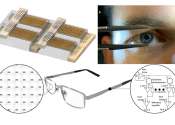Wireless pressure-sensing eye implant could help prevent blindness
Researchers at Caltech have developed an implantable pressure sensor that can reside in the human eye for years at a time while wirelessly sending data about the eye's health to the patient or medical professionals. The implant ...
Jun 29, 2018
0
371









